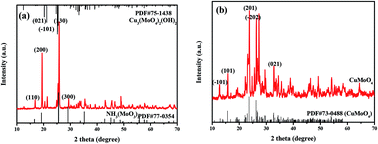Investigation into the synthesis conditions of CuMoO4 by an in situ method and its photocatalytic properties under visible light irradiation†
Abstract
A kind of molybdenum and copper compound, CuMoO4, was prepared by a hydrothermal method. The construction and photocatalytic properties of CuMoO4 have been characterized by X-ray diffraction (XRD), scanning electron microscopy (SEM), X-ray photoelectron spectroscopy (XPS), Fourier transform infrared spectroscopy (FTIR), Raman spectroscopy, transmission electron microscopy (TEM), UV-visible spectrometry and comprehensive thermal analysis. XRD analysis showed that samples which were synthesized under different hydrothermal time conditions were consistent, but the crystallinities of the samples were different. In another situation, disparate hydrothermal temperatures during the synthesis of CuMoO4 would lead to the appearance of different samples. The band gap of CuMoO4 was estimated to be 1.97 eV. It could be found from the results that CuMoO4 was an indirect band gap semiconductor by simulating its band structure. The photocatalytic activities of CuMoO4 were studied by means of monitoring the abilities of these compounds to degrade rhodamine B or 1H-benzotriazole in liquid media under visible light irradiation. Under different synthesis conditions, the hydrothermal time for obtaining the optimal degradation efficiency was 10 h, and the hydrothermal temperature was 180 °C. The results showed that CuMoO4 had excellent degradation performance for rhodamine B or 1H-benzotriazole. CuMoO4 showed excellent mineralization efficiency for rhodamine B compared with N-doped TiO2 based on the reduction of total organic carbon (TOC) during the photocatalytic process. The photocatalytic degradation rate of rhodamine B by CuMoO4 was 1.39 times that by N-doped TiO2, and the degradation rate of TOC by CuMoO4 was 1.53 times that by N-doped TiO2. Based on the intermediate products which were detected by liquid chromatography/mass spectrometry (LC/MS), the possible degradation pathway of rhodamine B was derived.



 Please wait while we load your content...
Please wait while we load your content...